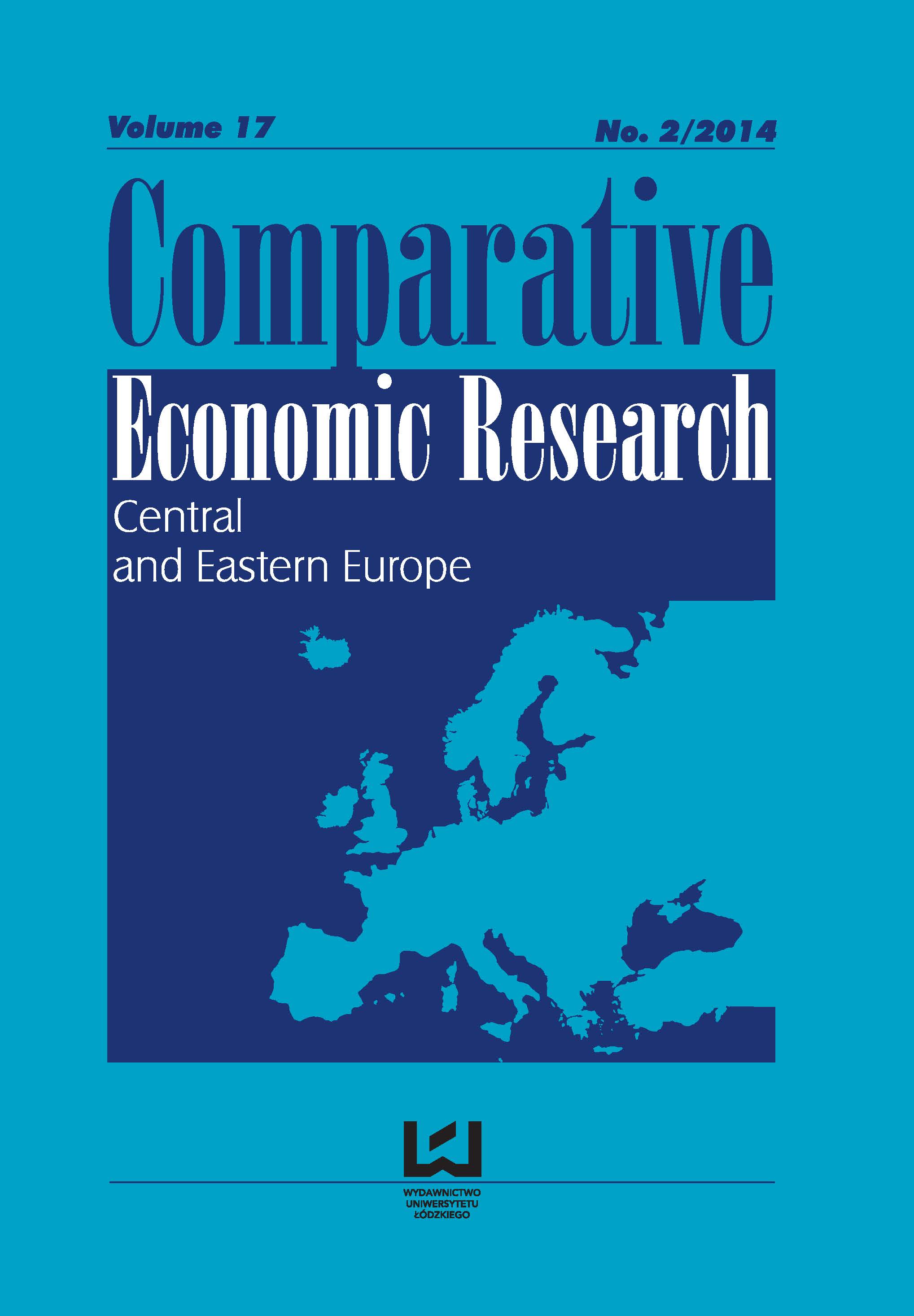Does Risk Aversion Matter for Foreign Asset Holdings of Pension Funds – The Case of Poland
DOI:
https://doi.org/10.2478/cer-2014-0018Keywords:
pensions funds, currency risk, international portfoliosAbstract
In this study we explore the issue of foreign assets in mandatory pension funds portfolios. First we provide an overview of the regulatory policies regarding international assets and indicate the externalitieswhich may account for the observed differences among the CEE states. Then, taking the perspective of portfolio theory, we run a simulation study to measure the diversification benefits that may be achieved by greater international asset allocation. By applying the specific constraints and exchange rate volatility to our optimization procedure, the study reflects the perspective of the Polish pensioner. However, the findings regarding risk aversion intensity and the discussed directions of further research should be of a universal character.
Downloads
References
Baxter M., Jermann U. J. (1997), The International Diversification Puzzle Is Worse Than You Think, ‘The American Economic Review’ 87, no. 1
Google Scholar
Beber, A., Brandt M.W., Kavajecz K. A. (2006), Flight-to-Quality or Flight-to-Liquidity? Evidence From the Euro-Area Bond Market, ‘NBER Working Papers’ 12376
Google Scholar
Boubaker H., Sghaier N. (2013), Portfolio optimization in the presence of dependent financial returns with long memory: A copula based approach, Journal of Banking & Finance 37, no.2 Carmona J. (2006), Revisiting Legal Limitations on Foreign Investing by Pension Funds, unpublished manuscript, available at: http://www.law.harvard.edu/programs/about/pifs/llm/sp12.pdf, [accessed on 28 July 2013]
Google Scholar
CampbellJ .Y., Serfaty-de Medeiros K., Viceira L.M. (2007).Global Currency Hedging,‘NBER Working Papers’ 13088
Google Scholar
Deng L., Ma C., Yang W. (2011), Portfolio Optimization via Pair Copula-GARCH-EVT-CVaR Model, ‘Systems Engineering Procedia’ 2
Google Scholar
Dimson E., Marsh P., Staunton M. (2006), The Worldwide Equity Premium: A Smaller Puzzle, ‘EFA 2006 Zurich Meetings Paper’,available at: http://papers.ssrn.com/sol3/papers.cfm?abstract_id=891620##, [accessed on 28 July 2013]
Google Scholar
Égert B. (2012), The Impact of Changes in Second Pension Pillars on Public Finances in Central and Eastern Europe, ‘OECD Economics Department Working Papers’ 942
Google Scholar
European Central Bank, The definition of price stability, available at: http://www.ecb.int/mopo/strategy/pricestab/html/index.en.html , [accessed on 28 July 2013]
Google Scholar
Federal Reserve System, Why does the Federal Reserve aim for 2 percent inflation over time?, available at: http://www.federalreserve.gov/faqs/economy_14400.htm, [accessed on 28 July 2013]
Google Scholar
Gonzalo J., Olmo J. (2005), Contagion Versus Flight To Quality In Financial Markets, ‘Universidad Carlos III, Departamento de Economía , Economics Working Papers’ we051810
Google Scholar
Markowitz H.M. (1952), Portfolio Selection, ‘The Journal of Finance’ 7, no. 1
Google Scholar
OECD (2013), Survey of Investment Regulations of Pension Funds, available at: http://www.oecd.org/daf/fin/private-pensions/2013_Survey_Investment%20Regulations.pdf, [accessed on 28 July 2013]
Google Scholar
Pension Funds Online, Country profiles, http://www.pensionfundsonline.co.uk/country-profiles, [accessed on 28 July 2013]
Google Scholar
Pfau W. (2011), Emerging Market Pension Funds and International Diversification, ‘Journal of Developing Areas’ 45
Google Scholar
PwC (2013), World in 2050, available at: pwc.com/gx/en/world-2050/the-brics-and-beyond-prospects-challenges-and-opportunities.jhtml, [accessed on 28 July 2013]
Google Scholar
Roldos J. (2004),Pension Reform, Investment Restrictions and Capital Markets, ‘IMF Policy Discussion Papers’ 04/4
Google Scholar
Schwartz A.M. (2012), Impact of Financial Crisis on Pension Systems – Europe and Central Asia, ‘5th World Bank Contractual Savings Conference’, January 9-11, 2012, Washington D.C., available at: http://siteresources.worldbank.org/FINANCIALSECTOR/Resources/session1.pdf, [accessed on 28 July 2013]
Google Scholar
Segaert S., Võrk A. (2012), Annual National Report 2012. Pensions, Health Care and Long-term Care. Estonia, Assessing the socio-economic impact of social reforms project, [online], http://www.socialprotection.eu/files_db/1221/asisp_ANR12_ESTONIA.pdf, [accessed on 28 July 2013]
Google Scholar
Sercu P., Vanpee R. (2007), Home Bias in International Equity Portfolios: A Review, Manuscript, Katholieke Universiteit Leuven, available at: http://papers.ssrn.com/sol3/papers.cfm?abstract_id=1025806, [accessed on 28 July 2013]
Google Scholar
Sortino F., Satchell S. (2001), Managing downside risk in financial markets: Theory, practice and implementation, Butterworth-Heinemann Finance, Burlington
Google Scholar
Sortino, F., van der Meer R. (1991), Downside Risk: Capturing What's at Stake, ‘Journal of Portfolio Management’17, no. 4
Google Scholar
Suh J. (2005),Home Bias Among Institutional Investors: A Study of the Economist Quarterly, ‘Journal of the Japanese and International Economies’ 19, no. 1
Google Scholar
Swinkels L., VejinaD.,Vilans R.(2005),Why don’t Latvian pension funds diversify more internationally?,‘Erasmus Research Institute of Management, Report Series Research in Management’No. 2005-078
Google Scholar
Viceira L. M. (2010),Application of Advances in Financial Theory and Evidence to Pension Fund Design in Developing Economies[in:]Richard Hinz, Heinz P. Rudolph, Pablo Antolín, and Juan Yermo(eds.), Evaluating the Financial Performance of Pension Funds, The World Bank, Washington D.C.
Google Scholar
Downloads
Published
How to Cite
Issue
Section
License

This work is licensed under a Creative Commons Attribution-NonCommercial-NoDerivatives 4.0 International License.











